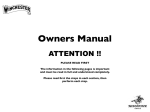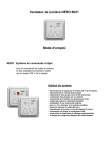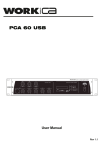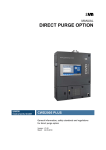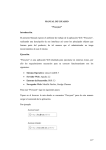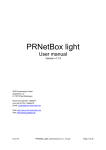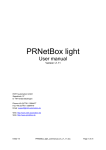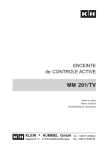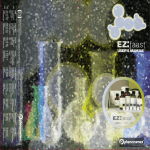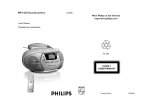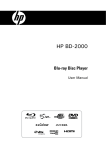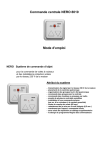Download User Manual
Transcript
User Manual gard mc CLARSON APPARATEBAU GMBH, Zeppelinstr. 4, D-78083 Dauchingen, Tel. +49 (0)7720/99 56-0, Fax 99 56-22 E-Mail: [email protected] www.clarson.de Master Station gard mc (surface) with display Display Keypad for dialling Priority/ Reset LED/system LED/microphone Microphone ON/OFF Group/ General Call Multifunction key Vol music „down“ and ENTER/confirmation Operating Instructions Master / Main Station Read this manual thoroughly before installation and operation of the system. Microphone Vol music „up“ / Call Forwarding Content 1. Preliminary steps .............................................. 3 1.1 Arrangement of the units ........................... 3 1.2 Volume Adjustment ................................... 3 Loudspeaker Master Station gard mc (recess) with display and directional swan neck microphone 2. Call and Conversation ...................................... 3 2.1. Call ............................................................ 3 2.2 Priority ....................................................... 3 2.3 Automatic Call Repetition for 30 sec ......... 3 2.4 Automatic Call Back .................................. 4 2.5 Treatment of Call-Backs ............................ 4 2.6 Microphone mute (mike OFF) ................... 4 2.7 Privacy („Do not disturb“) .......................... 4 2.8 Cancelling a communication ..................... 4 3. Special Calls .................................................... 4 3.1 Group Call ................................................. 4 3.2 General Call .............................................. 4 3.3 Answering Group/General Call ................. 4 Master Station gard mc (recess) with encapsulated stainless steel microphone Microphone 4. Call Transfer/Forwarding („follow me“) ............. 5 4.1 Call Transfer/Forwarding from own station ........................................ 5 4.2 Call Forwading („follow me“) ..................... 5 4.3 Call Transfer/Forwarding from another station .................................. 5 4.4 Conference ................................................ 5 5. Audio Programme Distribution ......................... 5 5.1 Music ......................................................... 5 6. Master Station .................................................. 6 6.1. Components Master Station ...................... 6 6.2 Master/Master Intercom ............................ 6 7. Master/Substation Intercom ............................. 6 7.1 Calling a Substation .................................. 6 7.2 Treatment of Substation Calls .................. 6 7.3 Selective suppression of Substation Call Signal at master station for individual substations ................................................ 6 Door Lock Release.................................... 7 8. Short-Guidance ................................................ 7 gardmc.doc 10/2009 Technical modifications reserved Page 2 1. Preliminary Steps 1.1 Arrangement of the units Clarson Gard MC is a microprocessor-controlled system operating in open duplex technology, i. e. simultaneous bi-directional voice transmission without pushing any buttons and without being influenced by ambient noises. 2. Call and Conversation Steps carried out at station A: 2.1 Call 1: A Enter the station number of B via numeric keypad (1). The number of station B flashes in the first display (10). Best transmission quality is achieved when the following points are observed: B min. 1 m Minimum distance between table station and loudspeaker = 1 m. 2: 10 -Stations with swan-neck require a microphone speaking distance of approx. 10 cm. 9 6 ca. 10cm Stations with omnidirectional microphone require a speaking distance of 1 m. 1.2 Volume Adjustment This adjustment should be made when installing a station. Readjustment might only be required if a station is moved to another place. 1 2 1 = Vol potentiometer 2 = Vol optional handset gardmc.doc 10/2009 The station calls itself when entering code *0. Rotate the station by 180. In the lower third there are 2 holes: under (1) the volume potentiometer is located. Turn the potentiometer with a small screwdriver till the point of feedback is reached. Then turn it slightly back till feedback disappears. 2.2 Priority Communication is established by pushing the ENTER key (6).The station´s diode (9) is illuminated if the station is disengaged. If the station is occupied, the diode flashes. The call number of station A flashes in the first display (10) of station B and the stations´s diode (9) is illuminated. The priority feature allows to disconnect any existing communication. Attention! The priority feature always interrupts a current conversation leaving one of the participants in a waiting loop. ! 1: Press the S key (5). 2: Press the ENTER key 9 5 6 (6). The station´s diode (9) is illuminated if the priority call has been successful. After terminating a priority call, the original communication is restored. 2.3 Automatic Call Repetition for 30 sec. Technical modifications reserved If station B is engaged, station A may wait 30 sec till station B is free and will then be connected automatically to station B. Otherwise the call is cancelled after 30 sec. This function is deactivated by pressing the # key (2). Page 3 2. Call and Conversation 2.4 Automatic Call Back If you don´t want to wait 30 9 ca. 3s 3.1 Group Call sec if the station is engaged, but make the station call you back: Press the ENTER key (6) until the dialled call number disappears from your display (10) and until the station´s diode (9) is out. 6 3. Special Calls A B C D E F Releasing a group call: Press subsequently 1 6 3 (3) 1. * key 2. Numeric keys (1) 3. ENTER key (6) Make your annoncement. If you wait for an answer, i. e. the person paged is expected to reply, don´t press the # key immediately thus allowing the person paged to reply (see 3.3). A group call is cancelled by pressing the # key. On your display (10) appears another call number whilst you are in conversation. Someone else is trying to reach you. Press the ENTER key(6) after terminating your conversation. You are immediately connected to the 2nd caller. 2.5 Treatment of CallBacks 6 Groups have single digit call numbers, f. ex. *1. Press the M key (4) to switch off the microphone. The microphone diode (8) is illuminated and reminds you of this function. 2.6 Microphone mute 8 4 3.2 General Call A C The microphone is reactivated by pressing the M key (4). 2.7 Privacy („Do not disturb“) ...1min. ca.2s 8 4 Switch off the microphone by pressing the M key (4) for approx. 2 sec till the microphone diode (8) flashes. A signal tone in intervals of approx. 1 min. reminds you of this function. Press the M key (4) to reactivate the microphone. The diode (8) will go out. E F There are 7 group calls. 8 + 9 are for special functions. Group and generall calls are priority calls. They always interrupt current conversations. Either station A or B cancels a conversation by pressing the # key (2). 6 2 10/2009 D The general call is kind of a group call and is normally released by pressing *1. 3.3 Answering Group/ General Calls 2.8 Cancelling a Communication gardmc.doc B Technical modifications reserved ! Reply to a group/general call is made by pushing the ENTER key (6). The person paged is automatically connected to the station which has released the group call provided that the call meanwhile has not been cancelled. Page 4 4. Call Transfer/Call Forwarding You are at station F and want to forward calls for station A to a third station C: 4.3 Call Transfer/ Call Forwarding from another station 4.1 Call Transfer/Call Forwarding („follow me) from own station A When leaving your room, all incoming calls may be transferred to your temporary location or to any other station. 1. Dial directory number of station A A F 2. Push (7) A Proceed as follows: C B 3. Dial directory number of station C. You are at station A and forward a call to station C: B C 1. Dial directory number When returning to your own station A, a square in the display bottom left and a signal tone in intervals of approx. 1 min. reminds you of the call forwarding. of A 2. Push the key(7) Reaction: Directory number A flashes in the display of station A. 3. Dial directory number of C 4. Confirm by pushing the ENTER key (6). Reaction: Your own directory number A disappears from the display. A square in the display bottom left and a signal tone in intervals of approx. 1 min. reminds you of the call forwarding. Cancelling the forwarding is made as follows: Cancelling see 4.1 C 1. Dial number of A 2. Push (7) 3. Dial number of C 4. Push ENTER key (6) 5. Audio Programme Distribution When returning to station A, the square in the display bottom left and a signal tone reminds you of the call forwarding. If your station is equipped with this feature, volume is adjusted individually by pressing (7) = „vol up“ and (6) = „vol down“ Cancelling see 4.1. 10/2009 During the conference the station numbers are flashing in the first and second display (10) of the involved stations and the stations´s diodes are illuminated (9). The conference may be cancelled by any participant pressing the # key Proceed as follows at C: gardmc.doc B 1. Dial number of stat. B 2. Push ENTER key (6) 3. Dial number of stat. C 4. Push ENTER key (6) A B Station A proceeds as follows: A You are at station C and want your calls (A) to be forwarded to station C. C A conference is possible between max. 3 stations. 4.4 Conference 1. Enter own directory number A 2. Push key (7) 3. Enter own directory number A 4. Push ENTER key(6) 4.2 „Follow me“ 4. Confirm by pushing ENTER key (6). 6 7 Technical modifications reserved These adjustments are made when the station is out of communication. Page 5 Communication with door stations or similar is established immediately. 5. Audio Programme Distribution Press keys simultaneously: –> music OFF 1 However, if cell or bed stations are concerned the station called has to push its speech button to switch on the station´s microphone. Press again keys simultaneously: –> music ON at medium volume 2 Communication is cancelled exclusively by the main/master station by pushing the # key (2). Basic adjustment (=vol max) is set via potentiometer (1), located on the case bottom. (2=optional handset) 7.2 Treatment of Substation Calls Substation calls are indicated successively in the display of the master station (10). 6. Master Station In case of more than 3 incoming calls the third display is flashing. Furthermore an audio signal is to be heard if the master station is not in communication. In general master stations consist of two elements: 6.1 Components Master Station - Audio Module with swan -neck microphone and loudspeaker (1) 2 - Operating Module with display and membrane keypad (2). 1 10 6 2 To treat a call with preference, proceed as per 7.1.: Each main station may operate as master station. 6.2 Master/Master Intercom See pos. 1 - 5 7.3 Suppresion of call signal at the master station for individual substations 7. Master/Substation Intercom A master/main station calls a substation as per pos. 1 5, however first push the S key (5). 7.1 Calling a Substation 5 2 gardmc.doc 10/2009 Calls are treated successively by pushing the key (6). In case of repeated unjustified individual substation calls the call signal at the master station can be suppressed: Whilst communicating press the following keys: 0 and ENTER (6). Cancel conversation by Communication is cancelby pressing #. the # key led by pushing (2). Signal tone is now deacti- Examples: vated, the station´s number flashes constantly in the display. Calling substation 1: S 1 Maximum 4 signal tones can be deactivated. or substation 13: S 13 Technical modifications reserved The call signal is reactivated automatically if a new communication is established with this substation. Page 6 Brief Instructions Volume Control *0 Station calls itself Calling a Master / Main Station - Station number + (f. ex. 1 ) Calling a Substation - S + station no. + (f. ex. S1) Answering Substation - –> Calls are treated successively Calls SXX –> a station is treated with preference Cancelling a Call Call Forwarding/ Call Transfer (from own station) cancel - Own station no. Own station no. Call Forwarding/ Call Transfer (from another station) - Own station no. Forwarded station no. cancel Call Forwarding („Follow me“) - # cancel Priority - S + (LED on) Conference (A + B + C) - M –> LED on - M –> LED off cancel Microphone Mute activate cancel - Push M for approx. 2 sec –> LED/mike flashes + signal tone cancel - Push M –> LED/mike OFF signal tone OFF Group Call - *X General Call - *1 Automatic Call Repetition for 30 sec - Automatic switch off after 30 sec or cancel with # Automatic Call Back - Hold down till directory number disappears from display and LED switches off gardmc.doc 10/2009 see above - Own directory no. Forwarded station no. see above - A dials station no. B A dials station no. C A, B or C push # Audio Programme Distri- - Volume Adjustment = „vol up“ bution = „vol down“ Privacy (“Do not disturb“) activate - Own station no. Forwarded station no. Door Lock Release S + call no + + S (example: S1S) or + S Selective suppression of substation calls at the Push master station 0 and CLARSON APPARATEBAU GMBH POB 11 63 D-78080 Dauchingen / GERMANY +49 (0)7720 99 56 - 0 +49 (0)7720 99 56 - 22 E-mail: [email protected] http://www.clarson.de Technical modifications reserved Page 7







